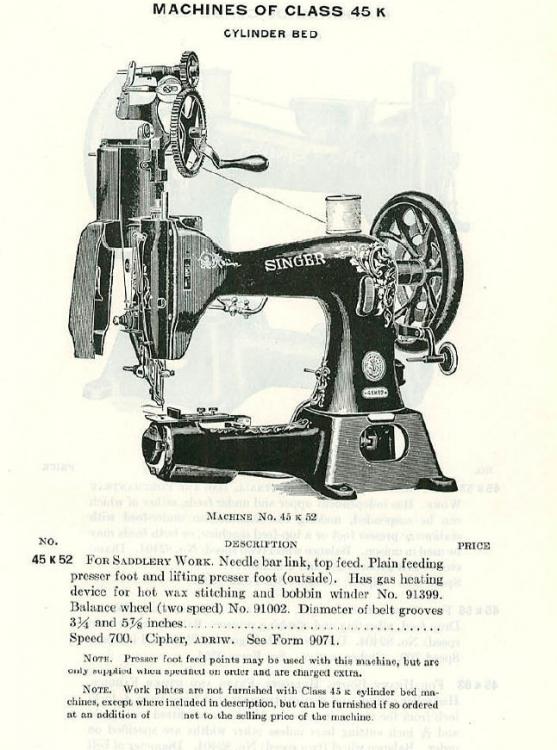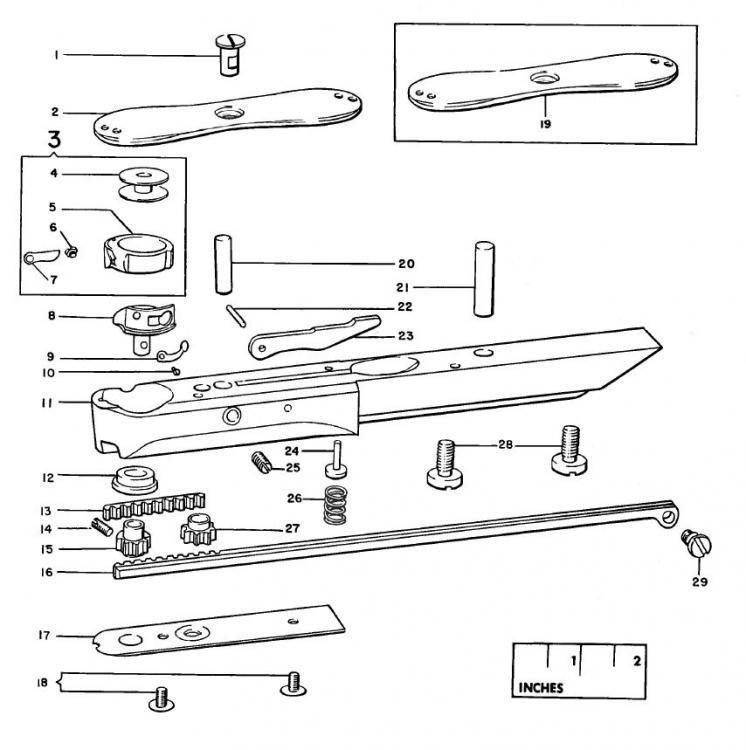-
Posts
5,713 -
Joined
-
Last visited
Content Type
Profiles
Forums
Events
Blogs
Gallery
Everything posted by Constabulary
-
Vintage Singers are work horses. I have a 133K3 from 1932 - and it still works very well! Here are pictures of the main tension unit but w/o the two felt / leather washers. The washers go between the disc and pulley, they are approx 1mm thick. Jimi is "Mr. 45K" so your are in good hands with your machine
- 21 replies
-
- singer 45k52
- singer
-
(and 2 more)
Tagged with:
-
This 45K model originally had a wax heating unit but I guess you don´t have it, right? You will not find other parts than needles, shuttle, and maybe some smaller standard parts for this machine. You will have a hard time finding presser feet at all. This is not the "standard" 45 this one is quite special so parts are no longer available as the machines is tooooo old. To nowadays standards I´d say the machine is outdated but that means nothing as long as it serves you for the purpose you need it for. May I ask how much have you paid for this machine? Don´t know if you made the right choice. As long as the machine works for your purpose then why not. Seems to be a "top feed only" machine. It has no feed dog and needle feed would not work with this needle plate. I guess you can adjust the stitch length somewhere on the feeding mechanism, but I´m not sure. Otherwise it looks like a fixed stitch length machine as I don´t see a stitch length adjuster. Machine was made in 1916 but that means nothing when properly refurbished. Most 45K do not have reverse just as yours. I have to admit that I have not worked with this particular 45K (52 subclass) but with some other 45K and similar machines. So this 45K may have some "specialties". Machine looks correctly threaded. You can adjust the tension on the thumb screws of the pre tension unit (back of machine top of head) and on the main tension unit of the face place. Not sure if my eyes are cheating me but the tension spring on the main tension unit on the face plate looks a bit light and probably incomplete. Usually the 45K main tension unit has 2 discs, 2 felt washers, a pulley, a (quite) heavy tension spring and the nut on the stud. Are all these parts present on your tension unit? I can post a picture of the tension unit later. You also have to adjust the tension on the shuttle hook but that's mentioned in the manual Thread breaking can be caused by too much tension, wrong needle / thread combination, poor / too old thread, burr in the needle eye or on other parts the thread runs over. Here is a pictures how the original 45K52 setup looks like Sorry - I have to run....
- 21 replies
-
- singer 45k52
- singer
-
(and 2 more)
Tagged with:
-

Singer 31K18 & 31K48 - help!!!
Constabulary replied to Trevor Baret's topic in Leather Sewing Machines
you can also carefully tap the wheel on different spots with a hammer and a piece of wood while turning the wheel. But a gear puller is for sure the better idea. When the wheel is off check the shaft for rust and burrs where the shaft has the notch and grind down them with some sand paper or a file. -

Adler 67-63l. How big a needle can I get away with?
Constabulary replied to Matt S's topic in Leather Sewing Machines
Usually up to 138 thread (20 ticket) max with 140 needle. 180 and 200 needles will not work not only because of the too thick thread but the 180 / 200 needles will most likely not fit through the hole of the feed dog. The whole machine is not designed for it. -

Outside Presser Foot Bar broken, Pfaff 335
Constabulary replied to Stuggi's topic in Leather Sewing Machines
Ha - that's even better - never thought Pfaff parts could be "cheap" -
Looks pretty much as the guide I´m using on my 111G156. Where is the development in this guide? Maybe I´m missing something but this is the same as the Kwokhing with just another mounting bracket. Could not be too difficult to make a proper mounting bracket for the "standard" Kwokhing guide.
-

Outside Presser Foot Bar broken, Pfaff 335
Constabulary replied to Stuggi's topic in Leather Sewing Machines
I measured 8.75mm on both the Pfaff 345 and Singer 111 presser foot bar so I´m pretty sure you can use a Singer 111 presser foot bar on you Pfaff 335. However - I cannot make promises but this would be the least expensive solution. I'd say check with this seller regarding the length of the bars. Diameter wise it should work, I think. http://www.ebay.com/itm/SINGER-111W-FOOT-BAR-PART-208566-/301985798960?hash=item464fc19b30:m:m4-bjys6Vfts06MAhMqimsg -
I don´t know if you have many options when you need a roller foot for this machine. I don´t know the 51w51 in particular and if there is just one special roller foots for this machine. If you are unsure what to do you have to contact your local dealer or one of the well known dealer who have banners on top of this page and ask if they have a proper roller foot for your machine. Usually changing a presser foot bar is rather easy compared with needle hook timing or other adjustments. But if you don´t know how ask your dealer of post some pictures of your machine with removed faceplate so maybe some members here can help you. But first look for a roller foot - I have no suggestions for you - I'm sorry!
-

Outside Presser Foot Bar broken, Pfaff 335
Constabulary replied to Stuggi's topic in Leather Sewing Machines
I also have a parts list of the old version - send me a PM with your email and I´ll send you the two files by email -
I don´t think constant pressure will help you with the pin. I rave restored a few patchers already and never had bigger issued with this pin. Usually 3-4 hammer strikes will loosen it. The pin clamps in the driving rack arm and not in the casting and the pin is tapered so when you give it some hearty hammer strikes and I´m sure this will work. Have you tried a heat gun or blow torch for either problem? When you drill it out the roller pin and damage the driving rack you will most likely have problems installing a new roller properly.
-

Outside Presser Foot Bar broken, Pfaff 335
Constabulary replied to Stuggi's topic in Leather Sewing Machines
Original Pfaff parts are quite expensive most of the time. But sometimes you can interchange parts from different brand machines. F.I. - Duerkopp machines are using a lot of Singer parts (or the other way around). So what I would suggest it a Singer 111 presser foot bar. I can give you some measures later because I can compare a Pfaff 345 and Singer 111. It´s just a guess - I have to pull out my digital caliper and will post the measures later today You can replace it. In best case you can pull it out to the top when you have removed the thumb nut and parts below and loosen the set screws the presser foot is clamped with. Since you have a parts diagram it should not bee too difficult. I have an instruction book (User manual) for the old Pfaff 335 I can send it you by Email if you are interested send me a PM. -

Machine beginner Renaissance Faire
Constabulary replied to Goblinworx's topic in Leather Sewing Machines
I NEVER EVER would buy one of these sailrite LSZ thingies for heavy leather work. You probably have to climb over different thickness materials and the sailrite is a top and bottom feed not really a compound foot machine and it has no needle feed. Look at this BULLSHIT - I hope this will cure you from the idea of using this LSZ thingie for heavy leather work. Oh - and don´t forget to watch the 2nd Video - it show "how well" this thingie works for heavy leather -
There seems to be a roller foot for this machine but it seems to be a special roller foot or you have to replace the presser foot bar. Look at these pictures: http://www.usedvictoria.com/classified-ad/Singer-Post-Sewing-Machine_23628221
-
Click the F5 button and refresh the page and then try again uploading the resized images
-
I think you will have a hard time drilling a hole through the center of the small shaft of the shuttle carrier. And BTW there is a small screw going through the shaft of the shuttle carrier which attaches the driving gear to it. Check out a 29K parts list with exploded drawing (this is from a later model 29K but basically the same around the shuttle). #14 is the one of the tiniest parts in this machine but it kills your idea.
-
Not exactly for the 29K15 but this manual should give you the basic instructions. 29-4.pdf
-
College Sewing ships worldwide AFAIK. Not sure how much they charge for shipping to the US but shipping for small orders is around 8 GBP to Europe. But most parts you need are available on Ebay.com too. Or check with dealers who have add banners on top of this site. I grind down the rounded sides the way that the BCL moves freely up and down just like the old part when mounted to the revolving handle. Maybe you have to grind down some spots on the revolving handle too. This is a bit of trial an error. I think I have mounted it 5 or 6 time until it worked. A Dremel tool is very helpful for this.
-
I´d buy the parts new and modify them, thats for sure the better deal on the long view. I once restored a 29K1 maybe the thread is helpful for you:
-
Seems to depend on the machine and hook a little bit. On my 133K3 the best needle position for a turn seems to be when the needle is on the way up and almost leaving the material / the tip is still inside the material. My 111G156 and 307G2 do not have these problems at all. Basically I think the best needle position is all the way down (BDC) before the loop has been formed or when the stitch has been almost completed and the needle tip is still inside the material. But thats just a rough guess. But my 133K indeed acts a bit different...
-
The Singer in your picture is at least from the late 1950´s but most likely newer. You can tell that for the attached plaques. If the blurry picture is not cheating my eyes its still in the original condition. You for sure will find most of the wear parts for this machine w/o problems f.i. at College Sewing in the UK. The other one is probably 1 century old and as Shoepatcher said there are no longer parts available. The availability of parts is priceless if you want to use the machine for a longer period of time. How much is the Singer machine?
-
I have an Adler 48-7 which actually is the ADLER version (or call it a clone ) of the Class 17-30 Singer as far as I can see. Its a nice machines for light to medium work f.i. for the shoe industries or sewing finer leather goods. Personally I´d consider it more as a light duty machine as it has a quite tiny feed dog and also a quite small bobbin. But depends on from which end you are looking. If you did fabric work with f.i. a size 90 needle and 40 thread most of the time its more a heavy duty machine but when you have sewn saddles and holsters with a 200 needle and 11 thread it is a light duty machine. A size 120 needle and 30 thread is what it works well with. BTW - all metric sizes since you are from Sweden.
-
I have not worked on a 29-4 but a 29K-3 (the K probably makes a difference). I have installed new bell crank levers to older 29K´s and I´m sure the the feed motion ring slide works too but both may need some smaller modifications. You at least have to grind down the ring on the outside of the BCL a little bit. But as I said I´m not 100% positive the the 29K is using the exact same parts as the 29 (w/o K). You probably have to compare parts lists. But I would guess the parts are the same. I actually have a 29K3 parts machine because I had two 29K3 with broken parts (same as yours) so I made one machine out of them - let me know what you need and I will check if I have the parts. Where are you located?
-

Hand Wheel Desperately Needed adler 467
Constabulary replied to venator's topic in Leather Sewing Machines
Haven´t noticed Erics post - I´m sure he is the man for that! -

Hand Wheel Desperately Needed adler 467
Constabulary replied to venator's topic in Leather Sewing Machines
or Juki: http://www.ebay.com/itm/Hand-Wheel-Flywheel-110-71362-For-Juki-DDL-8300-DDL-8500-DDL-8700-Machine-/162018745696?hash=item25b911dd60:g:JpQAAOSw~bFWLqwu or Mitsubishi http://www.ebay.co.uk/itm/MITSUBISHI-DB-120-S-N-HANDWHEEL-MF10A0682-/290723355341 -

Hand Wheel Desperately Needed adler 467
Constabulary replied to venator's topic in Leather Sewing Machines
Don´t know how it looks and what the shaft diameter is but maybe you can try a different brand hand wheel with either similar shaft bore diameter of if the bore is smaller you probably know someone with a lathe. Maybe a SEIKO hand wheel. http://www.aliexpress.com/store/product/Industrial-sewing-machine-handwheel-synchronous-DY-car-car-initiative-turbine-head-pulley-hand-wheel-turbine-head/1901342_32459554146.html




